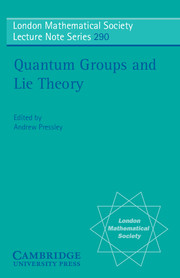Book contents
- Frontmatter
- Contents
- Introduction
- Lectures on Cyclotomic Hecke Algebras
- An Introduction to Group Doublecross Products and Some Uses
- Canonical Bases and Piecewise-linear Combinatorics
- Integrable and Weyl Modules for Quantum Affine sl2
- Notes on Balanced Categories and Hopf Algebras
- Lectures on the dynamical Yang-Baxter Equations
- Quantized Primitive Ideal Spaces as Quotients of Affine Algebraic Varietie
- Representations of Semisimple Lie Algebras in Positive Characteristic and Quantum Groups at Roots of Unity
- The Yang-Baxter Equation for Operators on Function Fields
- Noncommutative Differential Geometry and Twisting of Quantum Groups
- Finite Quantum Groups and Pointed Hopf Algebras
- On Some Two Parameter Quantum and Jordanian Deformations, and their Coloured Extensions
- Tensor Categories and Braid Representations
Noncommutative Differential Geometry and Twisting of Quantum Groups
Published online by Cambridge University Press: 05 November 2009
- Frontmatter
- Contents
- Introduction
- Lectures on Cyclotomic Hecke Algebras
- An Introduction to Group Doublecross Products and Some Uses
- Canonical Bases and Piecewise-linear Combinatorics
- Integrable and Weyl Modules for Quantum Affine sl2
- Notes on Balanced Categories and Hopf Algebras
- Lectures on the dynamical Yang-Baxter Equations
- Quantized Primitive Ideal Spaces as Quotients of Affine Algebraic Varietie
- Representations of Semisimple Lie Algebras in Positive Characteristic and Quantum Groups at Roots of Unity
- The Yang-Baxter Equation for Operators on Function Fields
- Noncommutative Differential Geometry and Twisting of Quantum Groups
- Finite Quantum Groups and Pointed Hopf Algebras
- On Some Two Parameter Quantum and Jordanian Deformations, and their Coloured Extensions
- Tensor Categories and Braid Representations
Summary
Abstract We outline the recent classification of differential structures for all main classes of quantum groups. We also outline the algebraic notion of ‘quantum manifold’ and ‘quantum Riemannian manifold’ based on quantum group principal bundles, a formulation that works over general unital algebras.
Introduction
There have been many attempts in the last decades to arrive at a theory of noncommutative geometry applicable to ‘coordinate’ algebras that are not necessarily commutative, notably that of A. Connes coming out of abstract C*-algebra theory in the light of the Gelfand-Naimark and Serre-Swan theorems. One has tools such as cyclic cohomology and examples such as the noncommutative torus and other foliation C*-algebras. Another ‘bottom up’ approach, which we outline, is based on the idea that the theory should be guided by the inclusion of the large vein of ‘naturally occuring’ examples, the coordinate algebras of the quantum groups Uq(g) in particular, and Hopf algebras in general, whose validity for several branches of mathematics has already been established. This is similar to the key role that Lie groups played in the development of modern differential geometry. Much progress has been made in recent years and there is by now (at least at the algebraic level) a more or less clear formulation of ‘quantum manifold’ suggested by this approach. After being validated on the q-deformation examples such as quantum groups, quantum homogeneous spaces etc, one can eventually apply the theory quite broadly to a wide range of unital algebras.
- Type
- Chapter
- Information
- Quantum Groups and Lie Theory , pp. 175 - 190Publisher: Cambridge University PressPrint publication year: 2002



